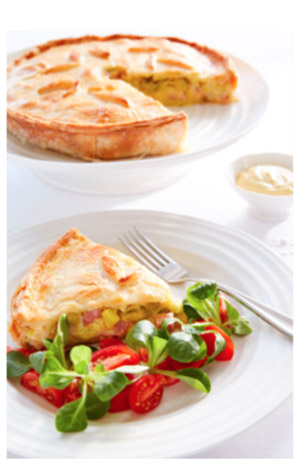Sophie Conran’s Organic Nature

“Hello this is Sophie. I’m sorry I can’t get to the phone right now, it’s either switched off or at the bottom of my handbag.” You can tell a lot about a person from her voice message. Sophie Conran is disarming, full of charm, and straight to the point. I was about to chat with a product developer extraordinaire, whose family tree is a who’s who of British tastemakers. On the second try, I reached the daughter of Sir Terence Conran, the creator of The Habitat Stores, sister of clothing designer, Jasper Conran OBE, and daughter of cookbook writer, Caroline Herbert. I imagined her sitting at a favourite haunt like the Ritz Hotel or gazing out at the grounds of her stately country home in Wiltshire. I was greeted by a welcoming voice. It was as if I had dialed my own sister- albeit with perfect British diction- and the conversation flowed as serenely as the ripples of Sophie’s eponymous dishware collection for Portmeirion.
“For all the best name brand dinnerware and home décor for less, join us at The William Ashley Warehouse Sale on from the 27th of April until the 5th of May. “
You started your career at sixteen working in fashion for the famous hat designer, Stephen Jones. What was that like? It was old-fashioned and we were stitching by hand and I would be sent out to get ribbons down a long dark corridor and there would be a room filled with boxes and boxes of silk flowers and there, there would be a woman with lashes of grey hair- very Victorian- puffing away at her cigarette. It was quite Dikensian. You imagine it’s all glamour and catwalks, but it was stitching with cold fingers… It was an introduction to hard work.

It wasn’t long until you became an interior designer. I fell into interior design by mistake. My dad (Sir Terence Conran) gave me shares in his company, Storehouse, and said you can do what you want to with it. So, I sold them and bought a flat in Bayswater, right beside Hyde Park near Kensington Palace. It had beautiful high ceilings. During the war the building had been abandoned and later was given to the homeless. In the eighties, when I bought the property, the leases were ending and the flats had been sublet and subdivided. So I took on this project of re-doing the space. It all came together very easily and instinctually. I opened it all up again. I redid the floors putting in fireplaces. And a lot of people were like: “Wow look what she’s done! Maybe she could do that for me.” I still live there.
It seems the word organic could be used to describe your career. How did Sophie Conran- the dishes- come to be?I had a pie business at the time and I was having dinner with a great friend of mine who was PR for Portmeirion. And at this very lovely party she asked me if I’d like to talk to them about doing a range. I was very interested and I loved the whole ethos of the company, the way it had been founded, very British, very eccentric, and run by this amazing woman. And I also sort of had personal ties to the business because my best friend’s mum had a collection (of Portmeirion). When I went there to have dinner, she would use them. I had a personal connection. And when we started (on development), about twelve years ago, I realized there was a lot of well-designed white dinnerware (on the market), but everything was computer generated and what had been lost was the human hand and the idea of craft and the idea that actually this thing you had in your hand is mud, it comes from beneath your feet, it’s earth. I wanted to put back that connection. So I worked with a potter. I would draw up shapes and he would throw them. I’m a great collector of ceramics. I pulled things out from my kitchen, including the pie dish I had developed during my pie business days…. And, my mother’s a cookbook writer and my brother (Tom Conran) is a restauranteur.
Did your mother, Caroline Herbert’s, writing influence you?One of the books she wrote when I was young was a book on British cooking and yes it did influence me. I was there when she was writing all her books and I was encouraged to help her in the kitchen to mix and stir and taste. Then we would talk about the experience. We were immersed in this wonderful education of cooking.

Let me get this straight, interior design to pies?In between, I was working for my brother Jasper (designer of the bone china Jasper Conran Collection for Wedgwood) and I was working very hard. I was in design direction and product development, working with the team on clothes, on jewelry, on night ware. The kids were very small and I would cook for them, to make their tea (dinner) the nanny would put in the oven for them the next day. I made quite a lot of pies and I had this feeling in me that I wanted my own business and I wanted to spend more time with my kids. I was in the bathtub and I thought, pies, everybody loves pies! So pies it was. It wasn’t particularly successful. I won a lot of awards and it led to the books and Portmeirion and what I am doing now. I am grateful for the pies.
If you could snap your fingers and design an item you have never worked on, what would it be? I think I would like to try electrical goods because electrical goods are not attractive. Basically, electrical goods are kind of horrible aren’t they? I think that would be a good challenge for me.
What would your process look like?I would do a lot of research. I would build up an image bank. I would look into the history of electrical goods. I would look at how they started. What preceded them? Often, when you look backwards things could have gone in many ways like a split branch of evolution. It’s exploring what was already there which will spark off different thought processes.
You develop an extensive range of products and you have been writing prolifically since your first book, Pies, was published in 2006. How do you re-energize as a person? I meditate twice a day. I spend lots of time with friends and family. I love a museum or a walk in the country. I eat great food. I work with great people.
The perfect weekend dinner? We have a big house in Wiltshire. It is a big project- a big gardening project and a big interior project. I’ll be working on it for the rest of my life. But, I am very spoilt. I have a chef. So I like to have fifteen to twenty people most weekends to dinner. We’ve got a big dining room. It’s all candle lit and the table is filled with beautiful flowers and lots of beautiful glassware and cutlery. The table always looks amazing. I work with my chef, Brone (pronounced brawny). She does a stunning job and I get to be with my friends and family.
Growing up, you were the only girl in a house full of boys. What do you think you passed on to your brothers?I can see what they have passed on to me… I guess… my nickname… I was called little mummy. I’m very concerned about their welfare. I bossed them about a lot when I was young because I always know best and yeah I am quite motherly.

What did you inherit from your father, the designer, Sir Terence Conran?Well, I think I learned to appreciate design. I learned to use my eyes. I’m always looking at things.
It’s interesting that a family such as yours has a tradition of democratic design. From the game changing design within reach of the Habitat Stores, conceived by your father, to your highly successful collection of dishware for Portmeirion. What’s on the horizon? At Portmeirion, we just launched a shell collection and we are launching a Christmas collection, which will be available in the fall.
At William Ashley we are always hungry for a new recipe. Since you write all the recipes for the food photographed with your products, I would like to channel veteran journalist Barbara Walters and ask: If you were a pie, what pie would you be? I would be a ham and cheese picnic pie. I like this one, apart from it being delicious and I wrote the recipe. I like it because it’s a picnic pie, because the idea of a picnic is always a getting together of friends. It’s going somewhere beautiful in nature and it’s an adventure.
Sophie’s Ham and Cheese Picnic Pie
A superb pie for a picnic and it’s fairly sturdy, covered with pastry all around making it nice and portable. It has a super cheesy case and is filled with gorgeous, satisfying flavour.

Serves 8
2 tablespoon olive oil
1 knob of butter, plus extra for greasing
1 onion, chopped
2 leeks, chopped, dark leaves discarded
500g short crust pastry, at room temperature
250g (9oz) piece of ham in a thick slice
3 eggs and 1 extra egg yolk
50ml double cream
300g Emmental cheese, grated
Salt and freshly ground black pepper
1 beaten egg to glaze
Pre-heat the oven to 220°c / 200°c Fan.
In a large pan heat the oil and butter. Add the onion and gently fry for 5 minutes. Add the leeks and fry them for 10 minutes or until they are soft.
Roll out two thirds of the pastry onto a floured board to the thickness of about 3mm.
Grease a 27cm flat tin and line it with the pastry. Prick the base with a fork about 15 times and cover with foil. Place in the oven on the middle shelf and bake for 10 minutes. Remove the foil and bake for a further 5 minutes until golden brown. Remove the pie case from the oven and allow to cool.
Chop the ham into 1cm cubes and set aside. Beat the eggs and cream together and mix in the cheese, onions, leeks and ham. Season the mixture with plenty of pepper and pour into the baked pastry case.
Roll out the rest of the pastry into a disc large enough to cover the pie. Lay the disc over the pie dish and trim to fit, decorating the top with any excess pastry. Brush with a beaten egg and cut a small hole in the top to let the steam escape. Cover with foil and place in the oven and bake for 20 minutes, then remove the foil and bake for a further 10 minutes.
Allow the pie to cool before turning it onto a plate. To do this, cover the top of the pie with a plate, flip it over, lift off the flan tin and then flip back carefully onto another plate.
Serve with a tomato salad, pickles and mustard.
Interview by Sujeet Sennik









